Build-Up for Operation Iraqi Freedom
Twenty years ago, on March 17, 2003, after weeks of deadlines and demands for compliance with UN inspections, President George W. Bush delivered a final deadline to Saddam Hussein before Operation Iraqi Freedom officially began. The leader of Iraq and his two sons were given a 48-hour ultimatum to vacate the country, or “their refusal to go will result in military conflict commenced at a time of our choosing.”
Operation Iraqi Freedom (OIF) began at 8:30 pm CT on March 19, 2003 (2:30 UTC on March 20, 2003) when U.S. forces commenced the attack.
The outbreak of war came after weeks of troop build-up in the Persian Gulf area. After Operation Desert Storm in 1991, U.S. troops remained in Kuwait to restore the country and provide regional security, so the 3rd Infantry Division of the U.S. Army was already training in Kuwait in September 2002. Further units, like the I Marine Expeditionary Force (MEF), V Corp’s Headquarters, and the 101st Airborne Division arrived in Kuwait between January and March 2003. U.S. forces were joined by coalition forces comprised of supporting countries the United Kingdom, Australia, Poland, and others.
By the time President Bush issued his 48-hour ultimatum, 222,500 U.S. military personnel had gathered in Kuwait in preparation for military operations. By April, that number grew to 284,450 including 93,900 boots on the ground. The Wisconsin Army National Guard’s 32nd Division Military Police Company was one of the first units to deploy from Wisconsin - followed shortly thereafter by about 3,900 other Wisconsin troops.
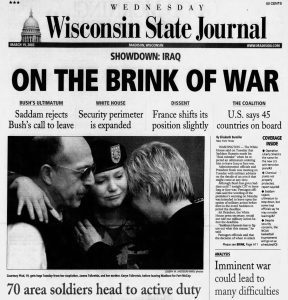
Wisconsin State Journal. (2003, March 19).
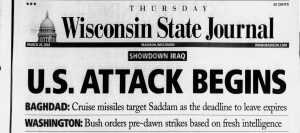
Wisconsin State Journal. (2003, March 20).
Hurry Up and Wait with Your Gas Mask
Jefferson, Wisconsin native Sergeant Jeffrey Carnes served as an Arabic linguist in the 101st Airborne Division and described his experience arriving in Kuwait on March 7, 2003.
Carnes said, “Kuwait is a desert wasteland. It was just nothing. It was kind of like the Bugs Bunny cartoons where it’s got a little arrow above the camel riding over the sand dunes. That’s what it looked like.”
After arrival, the units spent their time preparing for the invasion, completing exercises that would verify their courses of action, and waiting for their next orders. For example, V corps carried out a theater-level exercise that tested their plan for breaching the border of the berm, raised sand that was ten kilometers deep dividing Iraq from Kuwait.
Sgt. Carnes described the preparation and wait for the invasion into Iraq saying, “We just waited around, basically. Our vehicles showed up. We got everything ready. And it was kind of like one of those things where, okay, you got everything? Good, because you’re going to see--if you don’t have it, you’re not going to get it.”
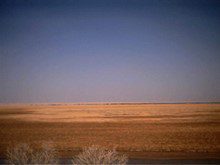
Photographs of the Iraq desert, taken by Jeffrey Carnes. WVM Mss 2051
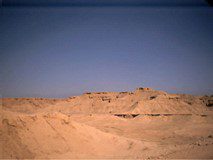
Staff Sergeant Timothy La Sage, of Germantown, served in the 2nd Battalion, 5th Marines, provides insight into their arrangements, saying, “On the 19th of March of 2003, we had pushed up from some fighting holes, about three kilometers shy of Iraq. We were in Kuwait, about three kilometers shy. We lived in some holes. Other forces, they had set up tents and little facility areas, waiting to get the order to push up.“
Along with the waiting was a fear that Saddam Hussein would use chemical attacks. Staff Sgt. La Sage describes the preparation and the waiting: “So February first, we get into the country, into Kuwait, you go through classes; nuclear, biological, chemical training, because you’re worried about enemy dropping dirty stuff on you and all that. Lived in gasmasks in that tent. A lot of the pictures that I have is us just sitting there reading books in gasmasks, or we’re going out for a run in gasmasks, and all that stuff.”
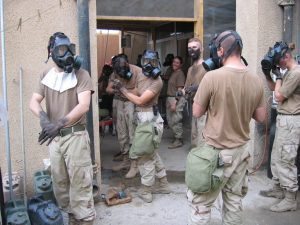
Photo of gas mask training from the Jeffrey Carnes Collection, WVM MSS 2051
Pushing Across the Border
On March 18, 2003, the 3rd Infantry Division received orders for the Invasion and moved into their attack positions. With aide from the Kuwaiti Armed Forces, they began making breaches into the berm.
After a successful breach, the leads of the U.S. Army’s 3rd Infantry Division began their travel through those openings as the 1st and 2nd Brigade Combat Teams formed battle positions within Iraq. The 3rd division, 7th Cavalry, executed a forward passage of lines. The movements of the teams marked the beginning of Operation Iraqi Freedom as they pushed towards the Talil Air Base and areas around Nasiriyah. The troops met light resistance from their firefights with the Iraqi regular army.
Staff Sergeant La Sage, describes his experience with the initial invasion of Iraq, “So, March 21st, we had pushed across the border, assaulted a few oil refineries, you know, the guards for around them, trying to keep them from lighting them on fire and all that stuff. We had ABC Nightline News embedded with us. Mike Cerre was the reporter’s name, and so he followed around and documented all the things that we were doing and watching us do our attacks. So we finally got the order to push up, full on war is declared and we’re off, off we go.”

